
University Vascular Associates
Marina Laser Vein Center
Marina Laser Vein Center
4560 Admiralty Way - Suite 356
Marina Del Rey, CA 90292
Call us at: (310) 823-7314
Welcome to Marina Laser Vein Center! Our fellowship-trained vascular surgeons utilize the most advanced minimally invasive treatment of vein disease.
We look forward to meeting you and providing you with the best possible care!
Treatments
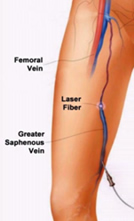 To effectively diagnose a patient showing symptoms of varicose veins, a physician will conduct a duplex ultrasound to determine if saphenous vein insufficiency is present. This is the most frequent cause of varicose vein formation. Once diagnosed, the physician will decide if endovenous laser treatment is an appropriate solution.
To effectively diagnose a patient showing symptoms of varicose veins, a physician will conduct a duplex ultrasound to determine if saphenous vein insufficiency is present. This is the most frequent cause of varicose vein formation. Once diagnosed, the physician will decide if endovenous laser treatment is an appropriate solution. The endovenous laser treatment is a 30-45 minute in-office procedure with no down time or scarring. The physician will determine the particular treatment procedure that is most appropriate for the patient. Generally, the skin is numbed before treatment. The vein is accessed percutaneously under ultrasound and an introducer catheter is inserted into the vein. The laser filament is inserted through the introducer. Once inside the vein, the placement of the laser filament is verified using ultrasound and by visualizing the aiming beam of the laser. Saline with lidocaine (numbing) solution is then infiltrated surrounding the entire vein. The laser is then slowly withdrawn as it emits energy. This laser energy seals the vein shut.
Once the procedure is complete, a compression dressing is placed on the treated leg for 2 days followed by 1 week of compression stockings. Under normal conditions the patient may return to work the following day.
The following are common physician recommendations:
- Wear compression stockings for a period of one week all the time, then 3 more weeks during the day
- Abstain from high impact activities such as running or step aerobics for a period of 3 weeks
- Walking is encouraged, as it will aid in the healing process.
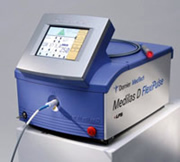 A repeat ultrasound will be done in 3-7 days to check the deep leg veins, and again in 4 weeks to ensure that the treated veins are sealed. Occasionally, a treated vein will reopen, requiring either injection of foam sclerotherapy or repeat laser treatment. 98% of treated veins are sealed shut at 1-year follow-up.
A repeat ultrasound will be done in 3-7 days to check the deep leg veins, and again in 4 weeks to ensure that the treated veins are sealed. Occasionally, a treated vein will reopen, requiring either injection of foam sclerotherapy or repeat laser treatment. 98% of treated veins are sealed shut at 1-year follow-up. As with any procedure, some mild side-effects might occur. You may experience a slight redness to your skin tone in the treated area, which will fade away within a few days. You might also notice a slight swelling in the treated area.
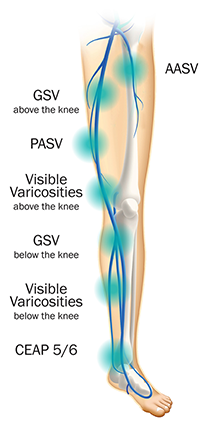 The Varithena treatment is effective for veins of different sizes above and below the knee. It requires no incisions, sedation or general anesthesia. It does not require a wire to be inserted along the length of the vein; does not use heat or glue and it dissolves in the bloodstream after treatment, leaving no foreign bodies in the vein. Because Varithena is minimally invasive and well tolerated by most patients, you may be able to resume most normal activities the same day as treatment.
The Varithena treatment is effective for veins of different sizes above and below the knee. It requires no incisions, sedation or general anesthesia. It does not require a wire to be inserted along the length of the vein; does not use heat or glue and it dissolves in the bloodstream after treatment, leaving no foreign bodies in the vein. Because Varithena is minimally invasive and well tolerated by most patients, you may be able to resume most normal activities the same day as treatment. Treatment with Varithena is minimally invasive and nonsurgical (no incisions required). The doctor usually numbs the injection site, but no additional anesthesia is required. It usually takes the doctor less than an hour to administer Varithena.
Patients may resume some activities the same day as treatment. Heavy exercises should be avoided for one week. Post-treatment bandages need to be kep dry and in place for 48 hours, and compression stockings must be worn on the treated leg for 2 weeks.
For a month, patients should walk at least 10 minutes a day and avoid long periods of inactivity.
For a month, patients should walk at least 10 minutes a day and avoid long periods of inactivity.
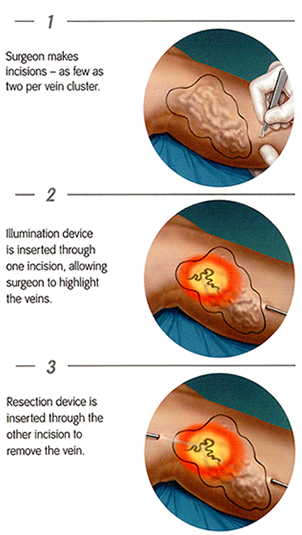 The TriVex System offers new, safer, more effective treatment to people who suffer from Varicose Veins. It was developed by Smith & Nephew, Inc., Endoscopy Division, in conjunction with, a leading general surgeon.
The TriVex System offers new, safer, more effective treatment to people who suffer from Varicose Veins. It was developed by Smith & Nephew, Inc., Endoscopy Division, in conjunction with, a leading general surgeon. Many patients resist treating their varicose veins because they are afraid of the pain and recuperative time involved with surgery. The Trivex System offers patients a minimally invasive treatment that lets them walk out of the hospital with few scars and be virtually pain-free within a couple of weeks.
The TriVex System is designed for use during a patented, clinically tested surgical technique for varicose vein removal called transilluminated power phlebectomy. (Transilluminated means that light is passed through the skin and phlebectomy is the medical term for vein removal.) In this procedure, the surgeon views the vein using a transilluminating light and removes it with a small powered surgical device.
While traditional varicose vein surgery is a "blind procedure," meaning that surgeons cannot always see the vein or confirm removal, The TriVex System's unique illumination feature allows the surgeon to quickly and accurately target and remove the vein and then visually confirm its complete extraction. This new process makes varicose vein removal more effective, complete and less traumatic for patients, by reducing the number of incisions required to perform the procedure and the duration of the surgery. Studies suggest that this method not only reduces the pain associated with varicose vein removal but also reduces the potential post-operative infection.
The procedure is performed on an outpatient basis and usually takes less than an hour. In one study comparing results from minimally-invasive surgery to those obtained with the older technique of hook phlebectomy, the minimally-invasive procedure cut operating time in half, reduced the number of incisions by 50 to 75 percent, required less anesthesia and caused less post-operative pain than the older sugery.
The TriVex System offers a much safer and more effective means to treat varicose veins as opposed to outdated traditional methods. For more information about the treatment of varicose veins and the TriVex System call (310) 823-7314 or contact us.
Progression in Varicose Vein Treatment:
The *treatment for varicose veins* has come a long ways with many improvements. A common procedure was the Hook Technique. Complications with the Hook Technique included the following:
- Tedious procedure
- Difficult to perform
- Incomplete? - stab avulsion phlebectomy
- Multiple Incisions
- Incisions were difficult to "hide"
- Not up to date technology
- Painful recovery
- Lengthy recovery period
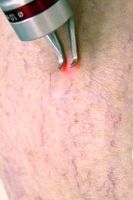 Surface laser treatment is used to eradicate spider veins. The laser beam is externally pointed at the veins to be treated, and the laser light energy is used to close the veins.
Surface laser treatment is used to eradicate spider veins. The laser beam is externally pointed at the veins to be treated, and the laser light energy is used to close the veins. Skin pigmentation can impact the effectiveness of any laser, therefore the patient should have no sun exposure four weeks prior to treatment to guard against blistering and scarring.
Although discomfort is mild, some form of cooling may be used to increase the patient’s comfort. Cooling may be achieved through the use of ice, a cool air device or topical anesthetic. The duration and number of sessions will vary depending on the severity of the condition and the location. Many facial veins can be treated in one session; however, most conditions on the leg require three to five treatments to ensure all spider veins are treated. These treatments are spaced four to six weeks apart.
Unlike most physicians who use only sclerotherapy, our doctors use the double injury method when treating spider veins on the leg. This technique treats the spider veins with the D940 SkinPulse S laser, followed by an injection of sclerosing solution into the associated reticular or “feeder” vein. Laser energy is applied first through a hand piece that is very small and lightweight. Spot sizes are easily interchangeable and come in 0.5, 1.0, and 1.5 millimeter sizes, depending on the size of the veins. By injuring the veins with the laser first, the vein spasms and less sclerotherapy is required. The benefit of the double injury method over sclerotherapy alone is a quicker resolution and a significant decrease in the risk of skin staining. Staining appears as brownish discoloration on the skin.
Once the procedure is completed, it is recommended that compression stockings be worn for three to five days. As with any procedure, some mild side-effects might occur. These side effects include slight redness to the skin tone or mild swelling in the treated area.
Common recommendations for the patient:
- Stay out of the sun and tanning beds for 4 weeks before and after surface laser treatment
- Wear compression stockings for a minimum of three to five days
- Abstain from high impact activities such as running or step aerobics for three weeks
- Walk at a moderate pace, as it will aid in the healing process
Although discomfort is mild, some form of cooling may be used to increase the patient’s comfort. Cooling may be achieved through the use of ice, a cool air device or topical anesthetic. The duration and number of sessions will vary depending on the severity of the condition and the location. Many facial veins can be treated in one session; however, most conditions on the leg require three to five treatments to ensure all spider veins are treated. These treatments are spaced four to six weeks apart.
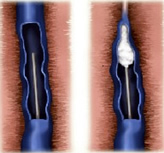 Sclerotherapy is an appropriate treatment of small- to medium-sized reticular veins that feed spider veins, or small varicose veins that remain after the endovenous laser treatment of reflux in the large saphenous veins. Occasional patients will also have perforator veins (connection between the deep and superficial veins) that are causing a skin ulcer. These are also well-treated with injection sclerotherapy.
Sclerotherapy is an appropriate treatment of small- to medium-sized reticular veins that feed spider veins, or small varicose veins that remain after the endovenous laser treatment of reflux in the large saphenous veins. Occasional patients will also have perforator veins (connection between the deep and superficial veins) that are causing a skin ulcer. These are also well-treated with injection sclerotherapy.Either visually or with ultrasound guidance, a tiny needle is used to inject foamed sclerosant into the vein. The lining of the vein then swells and eventually seals shut. The vein will usually fade in a few weeks. As with laser treatment, this procedure may take three to five treatment sessions. Staining, or brown discoloration on the skin, is a possible side effect to sclerotherapy and may take six months or longer to fade.


